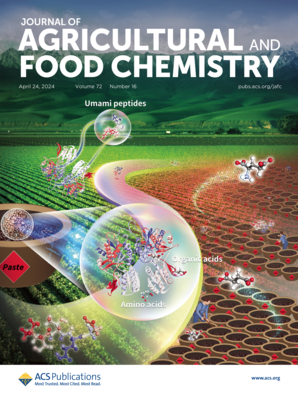Dual-Mechanism Quenching Electrochemiluminescence System by Coupling Energy Transfer with Electron Transfer for Sensitive Competitive Aptamer-Based Detection of Furanyl Fentanyl in Food
IF 5.7
1区 农林科学
Q1 AGRICULTURE, MULTIDISCIPLINARY
引用次数: 0
Abstract
Resonance energy transfer (RET) quenching is significantly important for developing electrochemiluminescence (ECL) sensors, but RET platforms face challenges like interference from other fluorescent substances and reliance on energy transfer efficiency. This study used Zn-PTC, formed by zinc ions coordinated with perylene-3,4,9,10-tetracarboxylate, as a dual-mechanism quencher to reduce the ECL intensity of carbon nitride nanosheets (Tg-CNNSs). Co3O4/NiCo2O4 acts as a coreaction promoter, enhancing and stabilizing the luminescence of Tg-CNNSs. Zn-PTC absorbs energy from Tg-CNNSs, altering the fluorescence lifetime to confirm energy transfer, while energy-level matching demonstrates electron transfer. By leveraging both RET and electron transfer mechanisms, the designed ECL aptasensor significantly reduces signal fluctuations that may arise from a single mechanism, resulting in more stable and reliable detection outcomes. The ECL aptasensor designed for furanyl fentanyl (FUF) detection shows excellent performance with a detection limit of 5.7 × 10–15 g/L, offering new pathways for detecting FUF and other small molecules.

通过能量转移与电子传递耦合的双机制淬灭电化学发光系统,用于基于竞争性色聚体的食品中呋喃芬太尼的灵敏检测
共振能量转移(RET)淬火对于开发电化学发光(ECL)传感器非常重要,但 RET 平台面临着其他荧光物质的干扰和对能量转移效率的依赖等挑战。本研究利用锌离子与过烯烃-3,4,9,10-四羧酸配位形成的 Zn-PTC 作为双机制淬灭剂来降低氮化碳纳米片(Tg-CNNSs)的 ECL 强度。Co3O4/NiCo2O4 可作为核反应促进剂,增强并稳定 Tg-CNNSs 的发光。Zn-PTC 从 Tg-CNNSs 中吸收能量,改变荧光寿命以确认能量转移,而能级匹配则证明了电子转移。通过同时利用 RET 和电子转移机制,所设计的 ECL 亲和传感器大大降低了单一机制可能导致的信号波动,从而实现了更稳定、更可靠的检测结果。为检测呋喃芬太尼(FUF)而设计的 ECL 亲和传感器性能卓越,检测限为 5.7 × 10-15 g/L,为检测 FUF 和其他小分子提供了新的途径。
本文章由计算机程序翻译,如有差异,请以英文原文为准。
求助全文
约1分钟内获得全文
求助全文
来源期刊
CiteScore
9.90
自引率
8.20%
发文量
1375
审稿时长
2.3 months
期刊介绍:
The Journal of Agricultural and Food Chemistry publishes high-quality, cutting edge original research representing complete studies and research advances dealing with the chemistry and biochemistry of agriculture and food. The Journal also encourages papers with chemistry and/or biochemistry as a major component combined with biological/sensory/nutritional/toxicological evaluation related to agriculture and/or food.

 求助内容:
求助内容: 应助结果提醒方式:
应助结果提醒方式:


